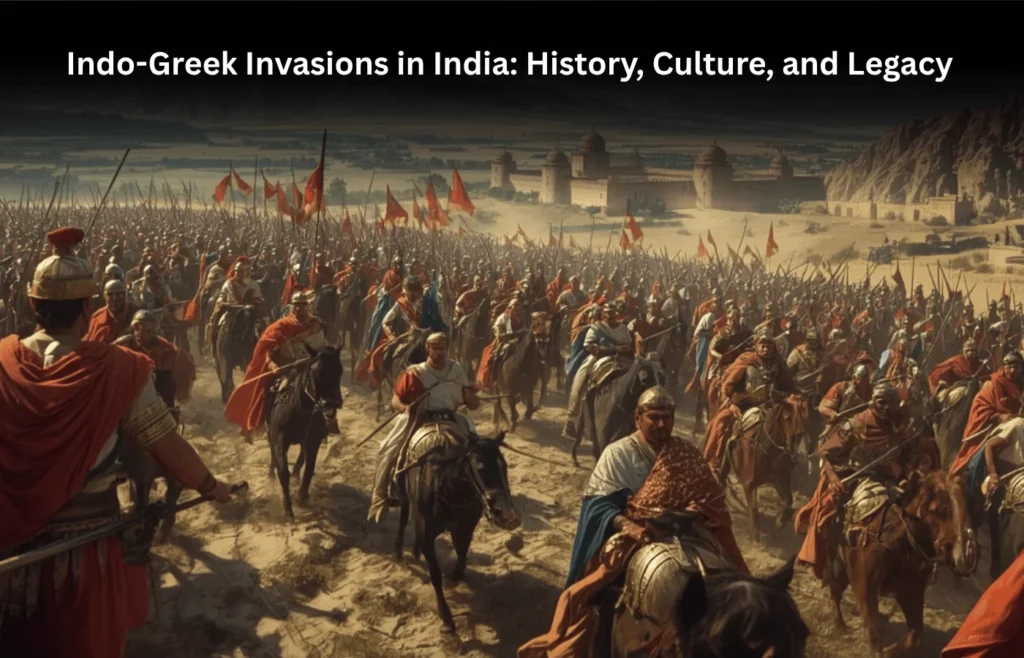
Introduction
The Indo-Greek invasions in India form a pivotal chapter in ancient Indian history, illustrating how power struggles in distant regions reshaped the subcontinent. The term “Indo-Greeks” refers to Hellenistic rulers who emerged in Bactria (modern Afghanistan and parts of Central Asia) after the decline of Alexander the Great’s empire. Alexander had marched into northwestern India in 327 BCE and returned to Babylon in 323 BCE, where he died. Following his death, his empire fragmented, and by the early 3rd century BCE, Bactria became a Greek stronghold under the Seleucid Empire before breaking away to form the Greco-Bactrian Kingdom around 250 BCE. From this base, the Indo-Greek kings began their incursions into Indian territories by the early 2nd century BCE.
The invasions were significant not only for the immediate political shifts they triggered but also for their long-lasting influence. Politically, the Indo-Greeks exploited the weakening of Indian powers following the fall of the Mauryan Empire in 185 BCE. Economically, their campaigns opened northwestern India more directly to Mediterranean and Central Asian trade routes, accelerating the movement of goods such as textiles, spices, horses, and precious metals. Culturally, their influence was even more enduring: Indo-Greek rulers like Menander I (Milinda), who reigned around 165–130 BCE, became patrons of Buddhism and introduced Hellenistic features into Indian coinage, art, and religious expression.
The historical context was crucial. After Emperor Ashoka’s death in 232 BCE, the Mauryan Empire gradually disintegrated, culminating in its overthrow by Pushyamitra Shunga in 185 BCE. The subcontinent fragmented into competing kingdoms such as the Shungas in the Gangetic plain and the Satavahanas in the Deccan. This political instability left India’s northwestern frontier vulnerable. For the Indo-Greeks, already under pressure in Bactria from nomadic tribes like the Yuezhi, these regions offered fertile land and strategic trade routes. Thus, their entry into India after c. 200 BCE was not just an invasion but also an adaptation to new opportunities—transforming Indian history by blending Hellenistic and Indic traditions in ways that would echo for centuries.
Background: From Alexander to the Indo-Greeks
Alexander’s Indian Campaign (327–325 BCE)

In 327 BCE, Alexander the Great crossed the Hindu Kush and launched his expedition into northwestern India. His forces clashed with local rulers, the most notable being King Porus at the Battle of the Hydaspes in 326 BCE. Though Alexander won, the fierce resistance of Indian warriors and the vastness of the subcontinent discouraged his troops from advancing further east toward the Ganges. By 325 BCE, Alexander retreated through the Indus Valley, leaving satraps and garrisons to secure his authority, but his hold over the region remained fragile.
Seleucid Control and Mauryan Resistance
The Diadochi, Alexander’s generals, split his empire after his death in 323 BCE. The northwestern territories of India eventually came under the control of Seleucus I Nicator (305–281 BCE), founder of the Seleucid Empire. However, Seleucus faced strong opposition from Chandragupta Maurya. Around 305 BCE, both rulers concluded a treaty: Seleucus ceded large territories of modern Afghanistan, Baluchistan, and Gandhara to the Mauryan Empire in exchange for 500 war elephants. This agreement ensured Mauryan dominance over India’s northwest while reducing direct Macedonian influence in the subcontinent.
Rise of the Greco-Bactrian Kingdom
By the mid-3rd century BCE, the Seleucid Empire began weakening in its eastern provinces. Around 250 BCE, the satrap Diodotus I declared independence and established the Greco-Bactrian Kingdom, centered in Bactria (present-day northern Afghanistan and southern Uzbekistan). Prosperous and strategically located along key trade routes, this kingdom quickly became a thriving Hellenistic state, blending Greek traditions with Central Asian influences. Its rulers harbored ambitions to expand into India, particularly after the Mauryan Empire began to lose strength following Emperor Ashoka’s death in 232 BCE.
Breakup of Seleucid Power and the Indo-Greek Emergence
The 2nd century BCE saw increasing turmoil. The Seleucid Empire fragmented further due to wars in the Mediterranean, and Bactria itself faced threats from nomadic groups like the Yuezhi. Amid these challenges, ambitious Bactrian rulers such as Demetrius I (c. 200–180 BCE) turned southward, crossing into the Indian subcontinent. Their campaigns coincided with the overthrow of the Mauryan dynasty in 185 BCE by Pushyamitra Shunga, creating a political vacuum in northern India. Out of this setting emerged the Indo-Greek rulers—no longer just successors of Alexander but sovereigns in their own right, whose legacy would deeply influence Indian politics, trade, religion, and culture.
First Indo-Greek Invasions into India
Demetrius I: The Pioneer of Indo-Greek Expansion
The first significant ruler to invade India was Demetrius I of Bactria (c. 200–180 BCE). He inherited a powerful Greco-Bactrian kingdom from his father, Euthydemus I, and sought to extend its influence beyond the Hindu Kush. Demetrius is often regarded as the founder of the Indo-Greek presence in India, as his campaigns marked the transition of Greek power from Central Asia into the subcontinent itself. Historical sources, including the works of ancient writers like Justin, confirm that Demetrius led large-scale expeditions into Indian territories, thereby laying the foundation for Indo-Greek rule.
Expansion into Gandhara and Punjab
Demetrius I’s conquests initially targeted the northwestern regions of India, particularly Gandhara (modern-day Peshawar Valley) and Punjab. These areas were not only strategically valuable—acting as gateways into the Indian heartland—but also rich in agricultural resources and trade connections. Control over Gandhara allowed the Indo-Greeks to dominate routes that linked India with Central Asia and the Mediterranean. In Punjab, the Indo-Greeks encountered remnants of Mauryan administrative systems, but the political vacuum left after the empire’s collapse made their advance comparatively easier. Archaeological evidence, especially coinage bearing Demetrius’s name and Greek iconography, suggests his authority extended deep into these regions.
Exploiting the Decline of the Mauryan Empire
The timing of Demetrius’s invasion was far from accidental. The death of Emperor Ashoka in 232 BCE had left the Mauryan Empire weakened, and by 185 BCE, the dynasty had been overthrown by Pushyamitra Shunga, founder of the Shunga dynasty. This transition created instability in northern India, particularly in regions far from Shunga control. Demetrius capitalized on this fragmentation, presenting himself not just as a conqueror but also as a protector of Buddhism, which had faced setbacks under the Shungas. His campaigns were thus fueled by both political ambition and the opportunity to appeal to local religious and cultural sentiments.
Establishing the Indo-Greek Foothold
While Demetrius did not extend his empire far into the Gangetic plain, his initial incursions set the stage for later Indo-Greek rulers, most notably Menander I (c. 165–130 BCE). The foothold established in Gandhara and Punjab created a durable Indo-Greek presence that endured for nearly two centuries. This early expansion marked the beginning of a new phase in Indian history where Greek political power blended with local traditions, influencing governance, coinage, and even religious patronage.
Major Indo-Greek Rulers and Their Indian Campaigns
Demetrius I: Establishing Indo-Greek Power
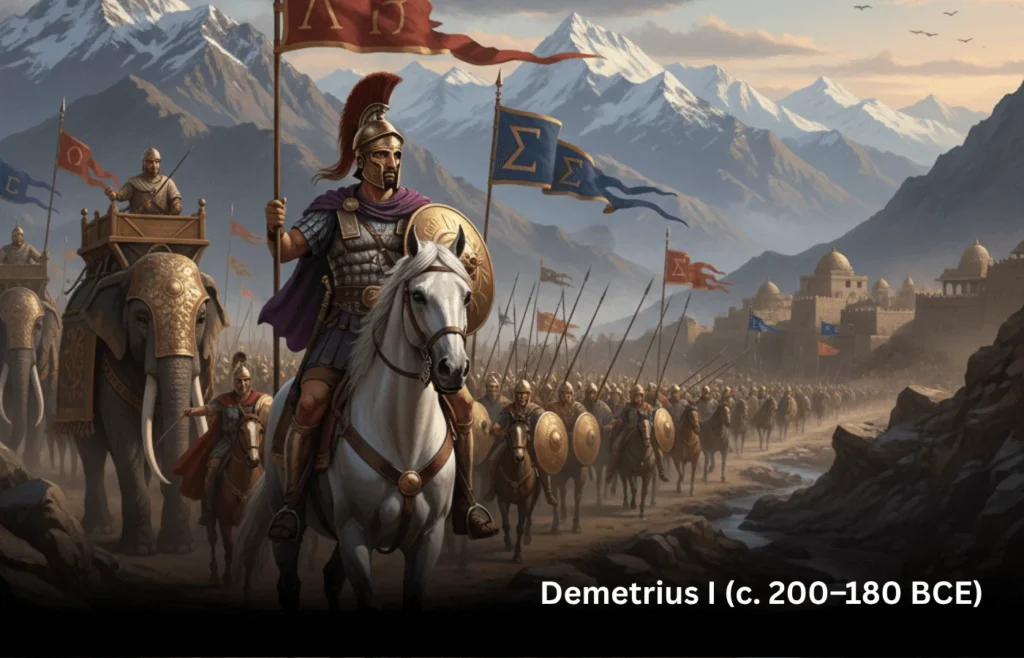
Demetrius I (c. 200–180 BCE) is credited as the founder of Indo-Greek rule in India. Building upon the strength of the Greco-Bactrian Kingdom, he crossed the Hindu Kush to extend his authority into Gandhara, Punjab, and parts of northwestern India. His campaigns capitalized on the weakened state of northern India following the Mauryan collapse in 185 BCE. Demetrius’s rule represented more than military conquest—it established a political base from which future Indo-Greek rulers could project power deeper into the subcontinent. Numismatic evidence, especially coins depicting elephants and other Indian motifs, reflects his attempt to legitimize authority in the region and appeal to local populations.
Menander I (Milinda): The Philosopher-King
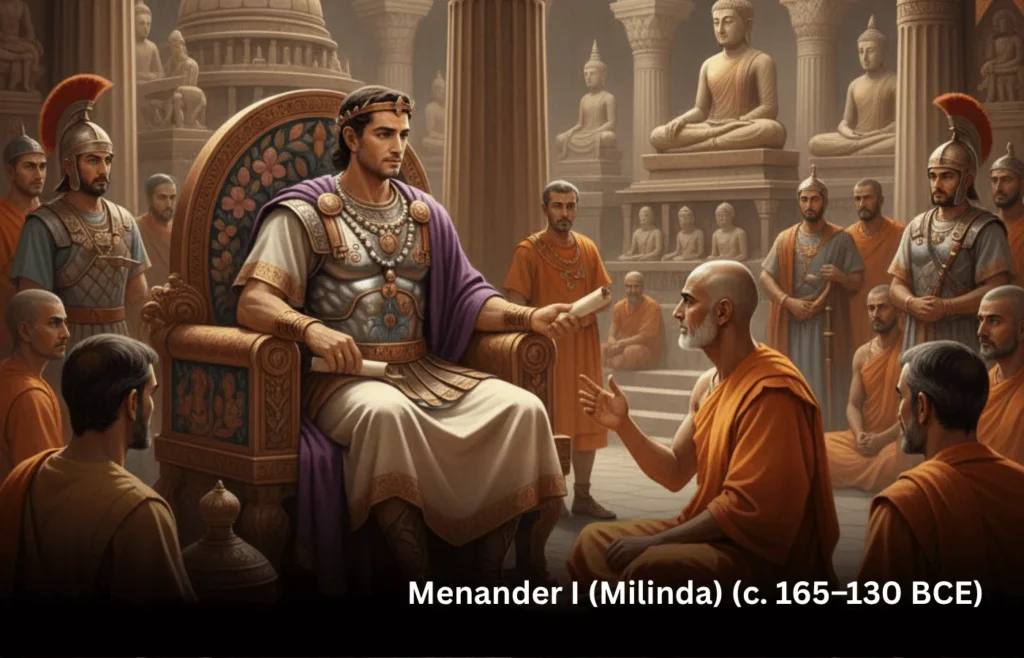
The most celebrated Indo-Greek ruler was Menander I (c. 165–130 BCE), remembered not only for his military conquests but also for his intellectual and religious contributions. Menander expanded Indo-Greek influence far beyond Punjab, reportedly pushing into the Ganges Valley, possibly reaching as far as Mathura and Pataliputra, the former Mauryan capital. His reign marked the height of Indo-Greek power in India.
Menander is immortalized in Buddhist literature through the Milinda-Panha (Questions of Milinda), a philosophical dialogue between the king and the monk Nagasena. This text portrays Menander as a ruler who embraced Buddhism, symbolizing the cultural synthesis between Hellenistic and Indian traditions. His conversion and patronage of Buddhism strengthened Greek legitimacy in Indian society while enhancing Buddhist expansion. Menander’s coins, bearing both Greek and Prakrit inscriptions, reflect his dual identity as a Greek monarch ruling over Indian subjects.
Other Significant Indo-Greek Rulers
While Demetrius and Menander dominate historical memory, several other rulers left their imprint on Indian history:
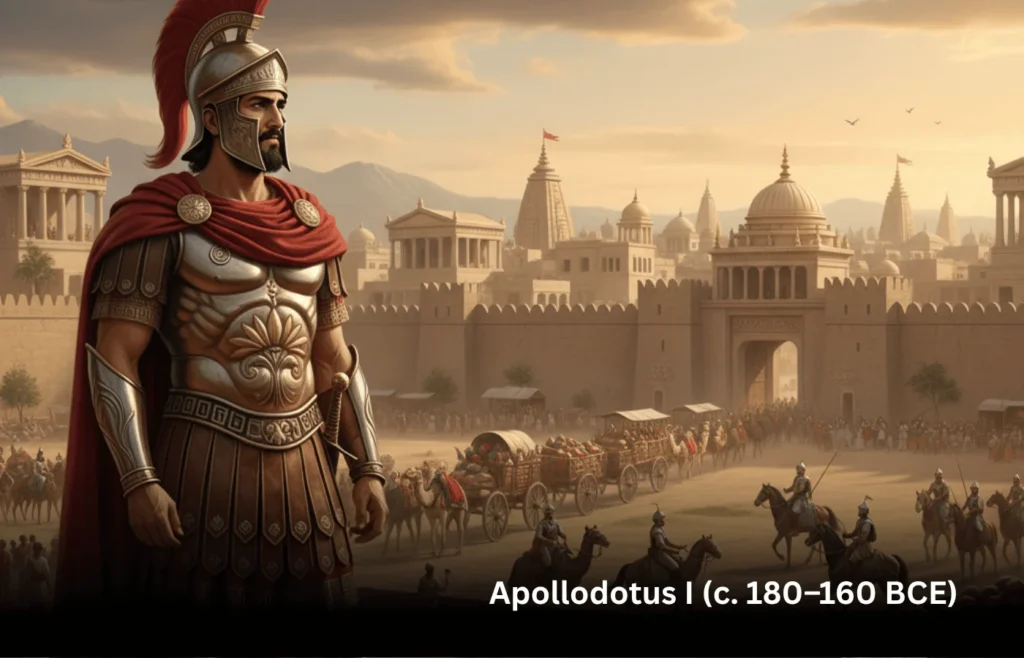
- Apollodotus I (c. 180–160 BCE): Considered one of the earliest independent Indo-Greek kings, he consolidated control over western Punjab and Sindh. His coins show both Greek and Indian deities, highlighting his effort to integrate into the cultural landscape of his Indian territories.
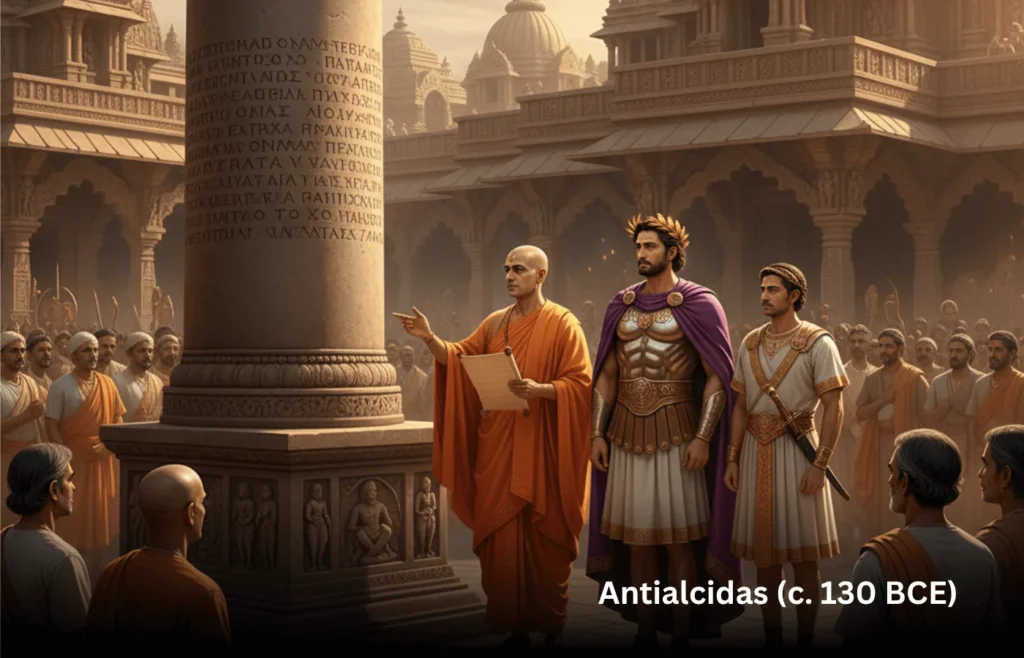
- Antialcidas (c. 130 BCE): Known from the Heliodorus pillar inscription at Vidisha (Madhya Pradesh), where his envoy Heliodorus dedicated a pillar to Lord Vishnu. This demonstrates both political diplomacy with local rulers and respect for Indian religious traditions.
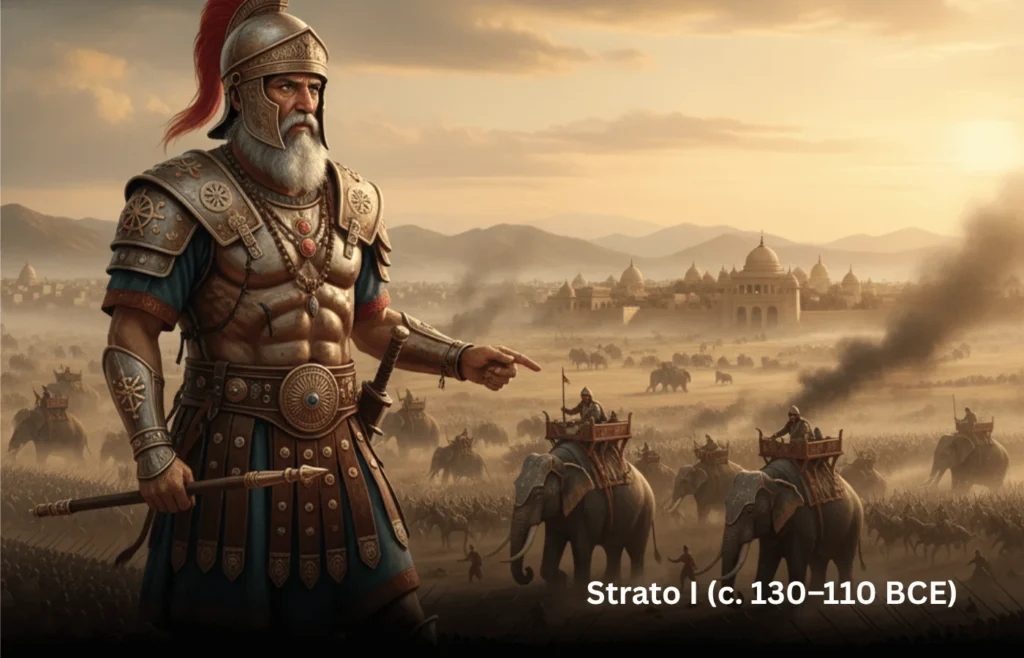
- Strato I (c. 130–110 BCE): One of the later Indo-Greek rulers, Strato I held sway over eastern Punjab and parts of the Ganges plain. His reign symbolized the gradual fragmentation of Indo-Greek authority, as his territories were increasingly contested by Indian powers and incoming Central Asian groups.
Alliances, Conflicts, and Rivalries with Indian Rulers
The Indo-Greek rulers did not operate in isolation; their history was intertwined with Indian dynasties. They engaged in conflicts and alliances that shaped the political landscape:
- With the Shungas (185–75 BCE): The Indo-Greeks were often in conflict with the Shunga dynasty, which arose after the fall of the Mauryas. Shunga hostility toward Buddhism may have further motivated rulers like Menander to champion Buddhist causes, gaining support among local populations.
- With the Satavahanas (2nd century BCE onward): The Satavahanas, rising in the Deccan, occasionally intersected with Indo-Greek politics, particularly in trade and border disputes, though their core interests lay further south.
- With regional Indian rulers: Indo-Greek kings formed temporary alliances with local powers, leveraging them to secure trade routes and strengthen their military campaigns. These interactions underscore the fact that Indo-Greek rule in India was not merely about conquest but also about negotiation, adaptation, and integration.
The campaigns of Demetrius I, Menander I, and their successors highlight the dual character of Indo-Greek rule: militarily ambitious and culturally adaptive. Through conquest, diplomacy, and religious patronage, they not only expanded their territories but also laid the groundwork for a unique Greco-Indian synthesis that influenced art, religion, and politics for centuries.
Political Impact on India
Weakening of Indigenous States
The Indo-Greek invasions coincided with a period of political instability in India. The fall of the Mauryan Empire in 185 BCE and the rise of the Shunga dynasty left northern India fragmented into competing regional kingdoms. The Shungas, though powerful in the Gangetic plain, struggled to project authority into the northwestern frontier. Local rulers in Gandhara, Punjab, and the Indus Valley were vulnerable to external threats, lacking the centralized structures once provided by the Mauryans. The Indo-Greek incursions further destabilized these states, as repeated invasions disrupted their ability to consolidate power. Over time, the balance of political authority shifted, forcing indigenous dynasties to share space with foreign rulers who brought new administrative and cultural models.
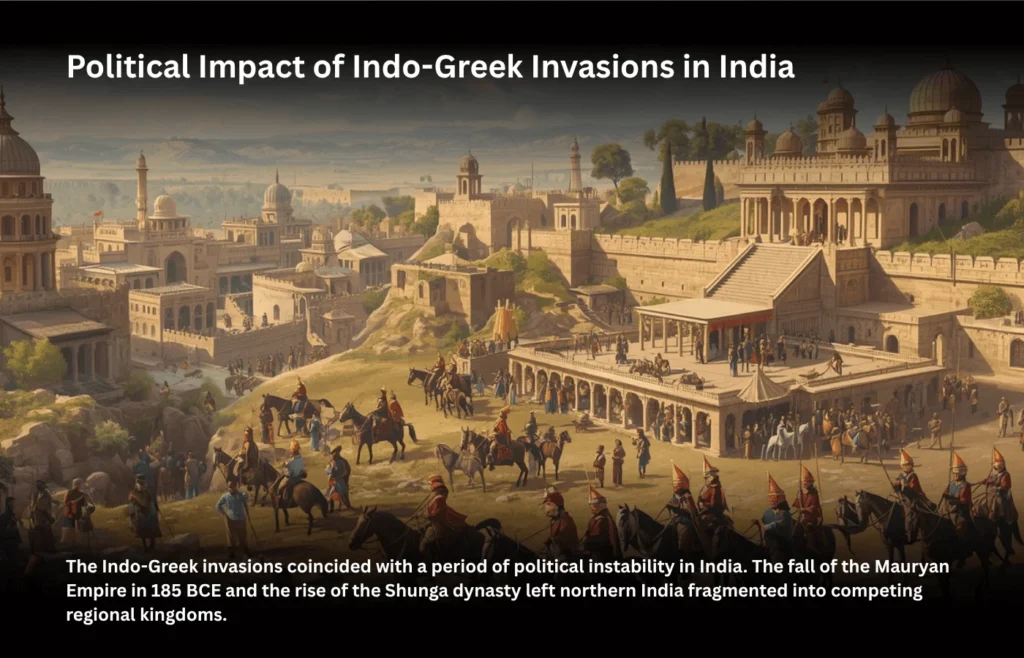
Rise of Hybrid Polities in Northwestern India
One of the most notable outcomes of Indo-Greek expansion was the creation of hybrid polities in northwestern India. Rather than merely imposing Greek dominance, Indo-Greek rulers integrated themselves into the local socio-political fabric. They established capitals such as Taxila and Sagala (modern Sialkot), which became centers of both Hellenistic governance and Indian traditions.
These Indo-Greek states were unique: they combined Greek systems of administration and coinage with Indian social and religious structures. Bilingual inscriptions on coins—Greek on one side, Prakrit or Kharosthi on the other—symbolized this fusion. The Indo-Greek kings often adopted local titles and iconography to legitimize their rule, blurring the lines between foreign conquerors and Indian monarchs. This hybridity not only strengthened their authority but also left a political legacy that influenced later Central Asian dynasties such as the Sakas and Kushans.
Military Innovations and Greek Tactics in Indian Warfare
The Indo-Greek invasions also introduced new military practices to the subcontinent. Indian warfare, traditionally dominated by infantry and elephants, began to adapt to Hellenistic strategies. The Greeks emphasized cavalry maneuvers, phalanx formations, and advanced siege techniques, which gave them an edge over regional kingdoms initially unprepared for such tactics.
The greater reliance on mounted cavalry, equipped with lances and bows, reshaped battlefield dynamics in northwestern India. This innovation had long-term effects, as subsequent invaders—the Sakas, Parthians, and Kushans—continued to use and refine cavalry-based warfare. Moreover, Indo-Greek minting of high-quality silver coins standardized currency in the northwest, indirectly strengthening the military by supporting trade and taxation systems needed to fund armies.
The Indo-Greek presence in India went beyond temporary conquest—it altered the political landscape in enduring ways. By weakening local states, creating hybrid Greco-Indian polities, and introducing military innovations, the Indo-Greeks reshaped power structures in the northwest. Their political legacy was not one of complete domination but of adaptation and synthesis, setting the stage for future Central Asian influences on Indian governance and warfare.
Cultural and Economic Influence of the Indo-Greeks
The Indo-Greek invasions left a profound imprint on Indian civilization. Beyond their military campaigns, they transformed the cultural, religious, and economic fabric of northwestern India. Their legacy is especially visible in the fields of art, religion, trade, and coinage, where Greek and Indian traditions fused to create something distinctly new.
Gandhara Art: A Fusion of Greek and Indian Aesthetics
One of the most remarkable contributions of the Indo-Greeks was in the sphere of art and architecture. The Gandhara school of art, which emerged in the northwestern regions of India, combined Hellenistic artistic techniques with Indian religious themes.

- Sculptures of the Buddha began to adopt realistic human features, inspired by Greek statues, with detailed drapery, curly hair, and naturalistic expressions.
- Greek architectural motifs such as Corinthian columns, vine scrolls, and acanthus leaves blended seamlessly with Buddhist stupas and monasteries.
This fusion laid the foundation for a new style that influenced Buddhist art across Central and East Asia.
Indo-Greek Patronage of Buddhism
The Indo-Greek rulers also shaped India’s religious landscape. Several kings, particularly Menander I (Milinda), are remembered for their close association with Buddhism.
- The king’s profound intellectual interest in Buddhist philosophy is demonstrated by the Milinda-Panha (“Questions of Milinda”), which documents a philosophical discussion between Menander and the Buddhist sage Nagasena.
- Menander is said to have embraced Buddhism, and after his death, Buddhist texts claim his relics were enshrined in stupas—an honor usually reserved for great Buddhist patrons.
- Greek rulers supported Buddhist monasteries, helping Buddhism spread along trade routes into Central Asia and beyond.
At the same time, many Indo-Greek coins and inscriptions also indicate respect for Hindu deities, showing a spirit of religious inclusivity that strengthened cultural integration.
Expansion of Trade Networks
Economically, the Indo-Greek presence in India opened up vital channels of international trade.
- The Indo-Greek territories connected the Indian subcontinent with the Hellenistic world of Central Asia and the Mediterranean.
- Goods such as spices, textiles, ivory, and precious stones flowed westward, while Greek wine, glassware, and metal goods entered India.
- This era also strengthened the Silk Road networks, establishing India as a key hub for East-West commercial exchange.
The increased trade not only boosted urban growth but also facilitated cultural interactions, making the Indo-Greek frontier one of the most cosmopolitan regions of the ancient world.
Coinage: A Medium of Political and Cultural Exchange
Indo-Greek rulers were pioneers in introducing Greek-style coinage in India, which became a hallmark of their influence.
- Coins were minted in silver, gold, and bronze, often bearing portraits of rulers on one side and Greek deities or Indian symbols on the other.
- Many coins featured bilingual inscriptions in Greek and Kharosthi/Prakrit, symbolizing the fusion of cultures and making them accessible to both Greek and Indian populations.
- These coins were not only instruments of trade but also tools of political legitimacy, projecting the king’s power while subtly integrating Indian religious symbols like the elephant, bull, or wheel (dharma chakra).
The legacy of Indo-Greek coinage influenced later dynasties such as the Kushans and Guptas, setting high standards of craftsmanship and iconography.
Lasting Legacy
The Indo-Greek cultural and economic contributions went far beyond their short-lived political dominance. By merging Greek artistic realism with Indian spirituality, patronizing Buddhism, stimulating long-distance trade, and revolutionizing coinage, they shaped a new era of cultural hybridity. Their influence continued to echo in Indian civilization long after their kingdoms had disappeared, making them one of the most significant foreign powers in ancient Indian history.
Decline of Indo-Greek Power in India
The Indo-Greek presence in India, which had reached its zenith under rulers like Menander I, eventually began to wane. Their decline was the result of a combination of internal fragmentation, external invasions, and shifting regional dynamics. Despite their cultural and economic contributions, the Indo-Greek political structure proved fragile in the face of these challenges.
Internal Conflicts and Fragmentation
One of the primary factors weakening Indo-Greek power was internal disunity. After the reign of Menander I (c. 165–130 BCE), succession disputes and rivalries among his successors, including Apollodotus II, Strato I, and Antialcidas, created a fragmented political landscape. Different rulers controlled isolated territories, often in conflict with one another, undermining central authority.
- The lack of a strong, unified leadership made it difficult to maintain control over distant regions such as Punjab, Gandhara, and the Gangetic plains.
- This fragmentation also weakened the ability of Indo-Greek kings to repel external threats and maintain economic stability, leaving their territories vulnerable to both Indian and Central Asian powers.
Invasions by Indo-Scythians, Indo-Parthians, and Kushans
As internal cohesion declined, India’s northwestern frontier became increasingly exposed to successive waves of foreign incursions:
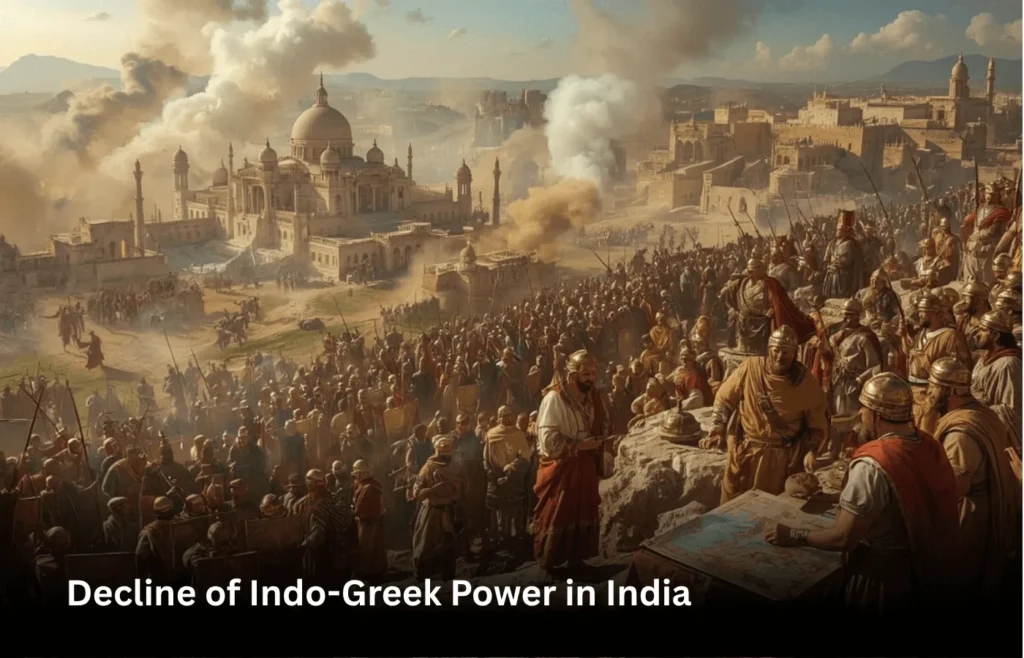
- Indo-Scythians (Sakas): Around the 1st century BCE, nomadic Saka tribes crossed the Hindu Kush and overran key Indo-Greek territories, including Gandhara and western Punjab. They established their own dynasties but retained some elements of Hellenistic governance and coinage.
- Indo-Parthians: Following the Sakas, the Indo-Parthians seized control over eastern Punjab and Sindh, further compressing the Indo-Greek sphere of influence. Their arrival marked the end of sustained Greek military power in India.
- Kushans: By the 1st century CE, the Kushans, originating from the Yuezhi confederation in Central Asia, advanced into northwestern India, integrating the remnants of Indo-Greek cities and trade networks into their empire.
These invasions were not only military defeats but also cultural transitions, as Greek influence gradually merged into the new Central Asian ruling traditions.
Retreat to Bactria and Final Disappearance
Following these external pressures, the Indo-Greek rulers were progressively forced to retreat from India and consolidate in their original heartland of Bactria (modern Afghanistan and Central Asia). By around 10 CE, the Indo-Greeks had effectively disappeared as a political force in the Indian subcontinent.
- Their retreat did not erase their cultural and economic legacy; Hellenistic traditions in art, architecture, coinage, and urban planning continued to influence subsequent rulers, particularly the Kushans.
- The Indo-Greek withdrawal also signaled the end of direct Greek military involvement in India, though their hybridized governance and patronage of Buddhism continued to resonate for centuries.
The decline of Indo-Greek power was a gradual process driven by internal discord and external invasions, culminating in their final retreat to Bactria by 10 CE. While their political authority faded, the Indo-Greeks left a lasting imprint on India’s northwestern frontier, influencing military practices, trade networks, and cultural expressions. Their story highlights the fragility of foreign kingdoms in India’s complex political landscape and underscores the enduring impact of their cultural and economic contributions.
Legacy of the Indo-Greek Invasions
Although the Indo-Greek political presence in India was relatively short-lived, their influence endured across multiple spheres—cultural, economic, and intellectual—shaping the subcontinent in ways that lasted for centuries.
Long-Lasting Cultural Fusion: Greco-Buddhism and Art
One of the most striking legacies of the Indo-Greeks was the fusion of Greek and Indian artistic and religious traditions, particularly visible in the Gandhara region.
- The Gandhara school of art exemplifies this synthesis, combining Hellenistic realism—such as naturalistic drapery, anatomical accuracy, and classical sculptural techniques—with Indian religious iconography, especially Buddhist motifs.
- Indo-Greek patronage of Buddhist monasteries and stupas helped lay the foundations for Greco-Buddhism, a cultural phenomenon that extended beyond India into Central Asia, China, and eventually Southeast Asia.
- Greek influence also persisted in numismatics, as Indo-Greek coins, with bilingual inscriptions and syncretic iconography, served as models for subsequent dynasties like the Kushans and Guptas.
This enduring cultural fusion demonstrates that, although their political dominance ended, the Indo-Greeks left a permanent imprint on Indian artistic and religious landscapes.
Northwestern India as a Gateway for External Influences
The Indo-Greek presence reinforced northwestern India as a key conduit for Central Asian and Mediterranean cultural, economic, and technological exchanges.
- The strategic location of Gandhara and Punjab along trade routes enabled the flow of goods, ideas, and religions between the Indian subcontinent and the broader Hellenistic world.
- Through these routes, India received not only material goods such as textiles, glassware, and coins but also ideas related to urban planning, administration, and military organization.
- This gateway function continued under later powers, including the Sakas, Kushans, and Guptas, allowing India to remain connected to trans-regional networks.
In essence, the Indo-Greeks institutionalized northwestern India as a hub for cultural and economic globalization in the ancient world.
Influence on Indian Political Thought and Philosophy
The Indo-Greek engagement with India was not limited to warfare or administration—it also contributed to intellectual and philosophical discourse.
- The Milinda-Panha, a classical Buddhist text, records a dialogue between King Menander I (Milinda) and the Buddhist monk Nagasena, exploring questions of ethics, consciousness, and governance.
- This text reflects how Greek rulers were not only political actors but also participants in Indian philosophical traditions, promoting cross-cultural dialogue and intellectual exchange.
- Beyond Menander, the Indo-Greek respect for local customs and religions set a precedent for subsequent foreign dynasties, fostering a tradition of rulers who engaged with Indian thought rather than imposing foreign ideologies entirely.
The Milinda-Panha remains a key historical source, illustrating the fusion of Greek and Indian reasoning and highlighting the Indo-Greek contribution to India’s philosophical heritage.
The legacy of the Indo-Greek invasions is enduring and multifaceted. They catalyzed a unique cultural synthesis through Greco-Buddhism and Gandhara art, strengthened northwestern India as a gateway for trans-regional trade and influence, and contributed to intellectual and philosophical traditions that bridged East and West. Even after their political decline around 10 CE, the Indo-Greeks continued to shape Indian art, religion, commerce, and thought, leaving an imprint that resonates in both historical scholarship and the material culture of the subcontinent.
Conclusion & FAQs
Recap of Political, Cultural, and Economic Impacts
The Indo-Greek invasions of India were far more than transient military incursions. Politically, they weakened fragmented indigenous states like the Shungas and local principalities, while fostering the emergence of hybrid Greco-Indian polities in northwestern India. Militarily, their advanced tactics, including cavalry maneuvers and Hellenistic formations, influenced Indian warfare for generations.
Culturally, the Indo-Greeks played a pivotal role in the creation of the Gandhara school of art, blending Hellenistic realism with Indian religious iconography. Religiously, rulers such as Menander I (Milinda) patronized Buddhism, exemplified by the Milinda-Panha, encouraging philosophical discourse and cross-cultural dialogue. Economically, their expansion reinforced northwestern India as a hub for Indo-Central Asian and Indo-Mediterranean trade, boosting urbanization and facilitating long-distance commerce.
A Turning Point in Indian History
The Indo-Greek invasions marked a significant turning point in Indian history. For the first time, northwestern India became a conduit for sustained interaction with Central Asia and the Hellenistic world. This engagement did not merely introduce foreign rulers; it created networks of commerce, culture, and knowledge exchange that shaped the subcontinent’s trajectory for centuries.
Through these interactions, India experienced an early form of globalization, with ideas, artistic techniques, and philosophical traditions traveling along trade and cultural corridors. The Indo-Greeks’ role in connecting India with broader Eurasian civilizations helped set the stage for subsequent waves of Central Asian influence under the Sakas, Indo-Parthians, and Kushans.
Cultural Synthesis Over Conquest
Unlike many foreign incursions that solely relied on subjugation, the Indo-Greek invasions fostered cultural synthesis rather than outright domination. Their rulers integrated with local populations, respected Indian religious traditions, and adopted bilingual administration and coinage. The result was a hybrid Indo-Greek civilization, which left enduring legacies in art, religion, commerce, and political thought.
In conclusion, the Indo-Greek invasions demonstrate that foreign incursions, when combined with diplomacy, adaptation, and cultural engagement, can result in lasting exchange and enrichment rather than mere conquest—an enduring lesson from ancient Indian history.
